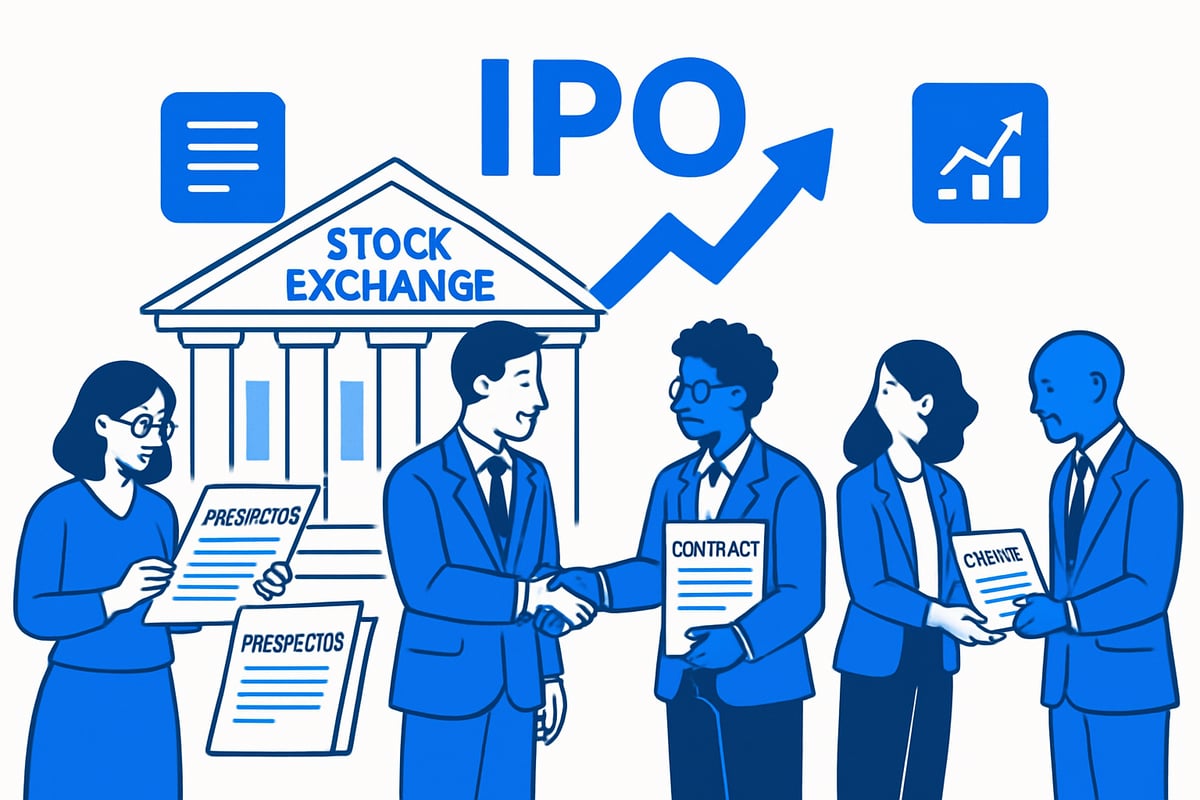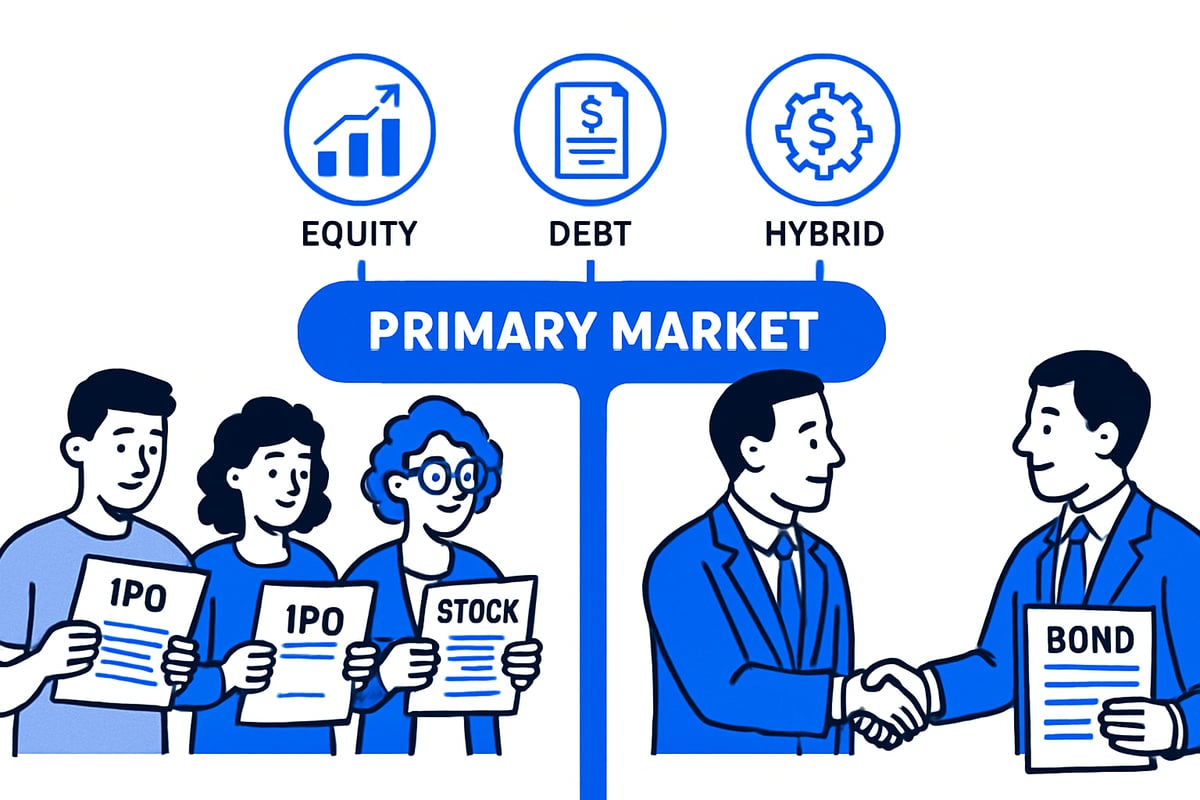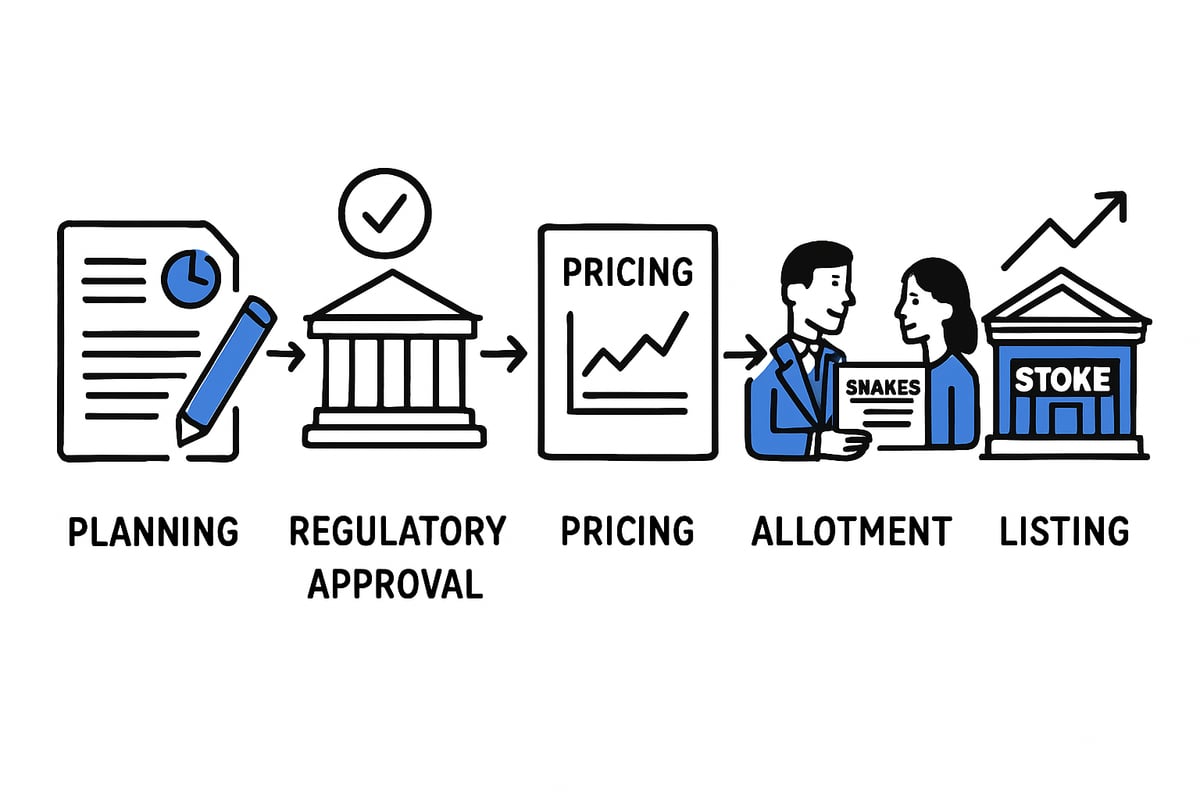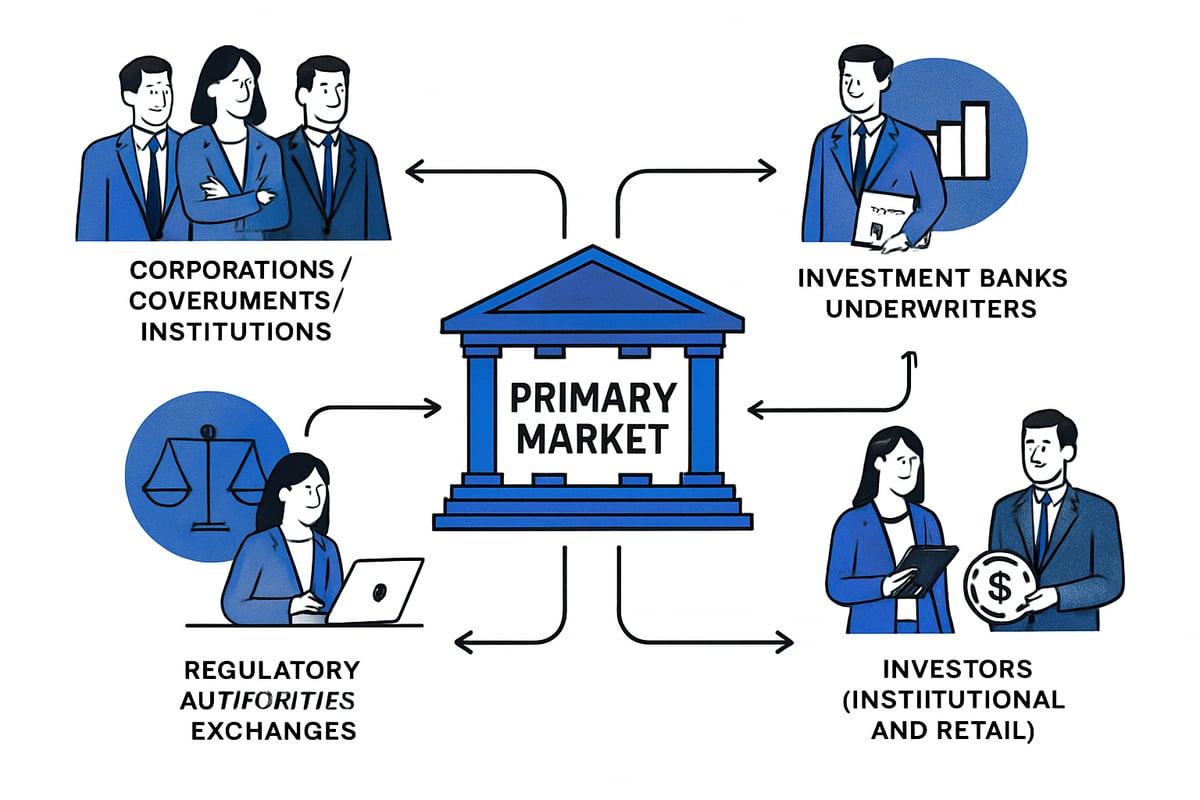Primary Market Guide: Understanding New Securities in 2025
A surge in new securities and capital market activity is anticipated in 2025, creating both exciting opportunities and greater complexities for investors and companies. Understanding the primary market is crucial, as it serves as the launchpad for new securities. Recent global IPO volumes and capital raised underscore its growing importance.
By mastering the primary market, investors can spot early opportunities, while issuers maximize their fundraising potential. This guide will explain essential concepts, processes, types of new securities, the latest regulatory changes for 2025, major risks, and best practices.
Stay with us for a comprehensive, up-to-date guide to navigating the primary market and new securities in 2025 with confidence.
What is the Primary Market?
Understanding the primary market is essential for anyone looking to navigate the world of new securities. This market serves as the first point of entry for investors and companies, shaping how capital is raised and allocated across the financial system.

Definition and Core Functions
The primary market is the segment of the financial system where new securities are created and sold directly by issuers to investors. This is where companies, governments, or institutions issue shares, bonds, or other financial instruments to raise funds for projects, expansion, or operations.
Unlike the secondary market, where securities are traded among investors after issuance, the primary market is all about the initial sale. For example, when a company goes public through an IPO, it offers its shares for the first time in the primary market. The funds raised go straight to the issuing company, fueling growth, innovation, or infrastructure development.
The economic significance of the primary market cannot be overstated. It acts as a launchpad for innovation and supports the building of new industries. In 2023 and 2024, global IPO activity saw a notable rebound, with over 1,300 IPOs worldwide raising more than $120 billion in capital, as detailed in Global IPO Trends Q2 2024.
Key participants in the primary market include issuers (the companies or governments raising money), investors (who purchase the new securities), underwriters (usually investment banks that help structure and market the offering), and regulatory bodies that oversee the process. This segment is often referred to as the “new issue market” because it deals exclusively with the first-time sale of financial instruments.
How the Primary Market Differs from the Secondary Market
One of the most important distinctions investors need to understand is how the primary market contrasts with the secondary market. In the primary market, securities are sold directly by the issuer to investors, meaning the issuer receives the proceeds. For example, during an IPO, a company raises money directly from those buying the new shares.
In contrast, the secondary market involves trading existing securities among investors, such as when shares are bought and sold on a stock exchange. Here, the proceeds from sales go to the investor selling the security, not the issuing company.
Let’s compare some core differences:
| Feature | Primary Market | Secondary Market |
|---|---|---|
| Who receives funds? | Issuer | Selling investor |
| Type of transaction | First-time sale | Ongoing trading |
| Example | IPO, bond issuance | Stock exchange trade |
| Price discovery | Set by issuer/underwriter | Determined by market |
| Liquidity | Limited (pre-listing) | High (post-listing) |
The primary market is crucial for setting the initial price of a security, while the secondary market helps establish ongoing prices through supply and demand. Both markets are essential, but understanding where and how new securities are introduced gives investors and issuers a strategic advantage.
Key Types of New Securities Issued in 2025
The primary market in 2025 is brimming with innovation, offering a diverse range of new securities for investors and issuers alike. Understanding these key types helps you navigate opportunities and risks as market dynamics evolve.

Equity Securities: IPOs, FPOs, and Rights Issues
Equity securities dominate headlines in the primary market, especially during periods of heightened public offerings. Initial Public Offerings (IPOs) are when a private company lists its shares for the first time, making them available to public investors. In 2025, IPO activity is rebounding, with global IPO volumes rising after a cautious 2023-2024. For instance, the Global IPO Watch H1 2025 highlights a surge in tech and green energy listings, with capital raised exceeding $120 billion in the first half of the year.
Follow-on Public Offerings (FPOs) allow already-listed companies to issue more shares, often to fund expansion or reduce debt. Rights issues, meanwhile, let existing shareholders buy additional shares, usually at a discount, preserving their ownership stake. Major rights issues in 2024 by multinational banks and energy firms raised billions, signaling strong investor appetite.
Here's a quick comparison:
| Security Type | Who Can Buy? | Typical Use Case |
|---|---|---|
| IPO | Public investors | Listing, raising capital |
| FPO | Public investors | Expansion, refinancing |
| Rights Issue | Existing shareholders | Capital boost, M&A |
These equity offerings in the primary market enable companies to fuel growth and give investors early access to new opportunities.
Debt Securities: Bonds and Debentures
Debt securities are another vital pillar of the primary market, allowing companies and governments to borrow funds from investors. Bonds are the most common form, offering fixed or variable interest payments over a set period. In 2025, the primary market continues to see a boom in green bonds and sustainability-linked debt, reflecting global demand for responsible investing.
Debentures and notes are similar to bonds but may differ in terms of security and repayment structure. Governments often issue sovereign bonds, while corporations launch both secured and unsecured debt. According to recent data, global bond issuance reached $8.2 trillion in 2024, with a significant share allocated to climate-related projects.
Investors in the primary market analyze features like coupon rates, maturity dates, and issuer creditworthiness. The rise of digital platforms is making bond subscriptions more accessible for both institutional and retail participants.
Hybrid and Alternative Securities
Hybrid and alternative securities blend features of both equity and debt, offering flexibility for issuers and unique benefits for investors in the primary market. Preference shares, for example, provide fixed dividends and priority over common shareholders in payouts, making them attractive to income-focused investors.
Convertible bonds are another popular hybrid, allowing holders to convert debt into equity shares at predetermined terms. This structure can appeal to investors seeking upside potential with downside protection. In 2025, companies are experimenting with other innovative securities, such as perpetual bonds and sustainability-linked preference shares, to attract a wider investor base.
Recent high-profile launches include convertible green bonds by tech firms and hybrid offerings targeting ESG-conscious investors. These instruments showcase the evolving landscape of the primary market, where creativity and customization are driving capital formation.
The variety of new securities in the primary market equips both issuers and investors with tools to meet their financial goals in a rapidly changing world.
The Process of Issuing New Securities: Step-by-Step in 2025
Navigating the process of issuing new securities in the primary market is essential for both companies seeking capital and investors looking for early opportunities. The journey from planning to trading involves several key stages, each with its own requirements and best practices. Understanding these steps empowers participants to make informed decisions and adapt to evolving market trends.

Step 1: Planning and Preparation
The process begins with thorough planning, where issuers define their objectives for entering the primary market. Typical motivations include raising funds for expansion, innovation, or debt repayment. Companies prepare audited financial statements, conduct internal reviews, and develop a strategic timeline.
Investment banks and underwriters play a pivotal role at this stage. They advise on optimal timing, help structure the offering, and assess market appetite. For instance, in 2024, several tech firms began laying the groundwork for high-profile IPOs, leveraging underwriters' expertise to position themselves favorably. According to the Global IPO Landscape 2024, robust planning is often the foundation for successful launches in the primary market.
A typical planning checklist includes:
- Reviewing capital requirements and business goals
- Selecting advisors and underwriters
- Preparing initial documentation
Step 2: Regulatory Approvals and Compliance
Once the groundwork is set, issuers must navigate regulatory approvals. In 2025, compliance is more complex, with enhanced ESG disclosures and stricter transparency standards. Key agencies like the SEC in the US and ESMA in Europe oversee the approval process, ensuring all prospectuses meet legal requirements.
Preparation of a detailed prospectus is crucial. This document outlines company financials, risks, and offering details. Regulators review submissions, and the timeline for approval can vary based on jurisdiction and completeness. Recent data shows that average approval periods have shortened due to digital filings, but common hurdles include incomplete disclosures or non-compliance with new rules.
Issuers in the primary market need to:
- Submit regulatory filings and draft prospectuses
- Respond to regulator queries
- Update documents as required
Step 3: Pricing and Marketing the Offering
With approvals in hand, the next step is pricing and marketing the new securities. There are several approaches to pricing in the primary market, including book-building, fixed-price, and auction methods. Book-building remains popular for IPOs, allowing underwriters to gauge investor demand and set a competitive price.
Marketing activities ramp up at this stage. Companies and their advisors organize roadshows, virtual presentations, and leverage digital platforms to reach both institutional and retail investors. Recent IPOs have seen increased use of online campaigns to broaden awareness. On average, IPOs are priced at a slight discount to ensure full subscription, and oversubscription rates remain a key indicator of market enthusiasm.
Key pricing and marketing steps:
- Finalize price range and offering size
- Conduct investor outreach and presentations
- Collect and analyze investor feedback
Step 4: Allotment and Distribution to Investors
Following successful marketing, securities are allotted to investors. Allocation in the primary market typically prioritizes institutional investors, though retail participation is growing thanks to digital platforms. Underwriters and syndicates manage the allocation process, balancing fairness and demand.
Oversubscribed offerings often result in pro-rata allotments, where investors receive a portion of their requested shares. Brokers and banks facilitate distribution, ensuring seamless settlement. For example, several 2024 IPOs experienced significant oversubscription, highlighting strong investor interest in the primary market.
Allotment checklist:
- Allocate securities to investors based on demand
- Communicate results to participants
- Coordinate with brokers and clearinghouses
Step 5: Listing and Commencement of Trading
The final stage is listing the new securities on a recognized exchange or bond market. This marks the transition from the primary market to the secondary market, where securities become freely tradable. The listing process involves meeting exchange requirements and finalizing all legal and administrative steps.
On the first day of trading, issuers and investors watch closely for the "first-day pop"—a rise in price above the offer level—which can signal strong demand. Recent data shows that well-prepared offerings in the primary market often experience positive initial trading performance, though outcomes can vary.
Key listing steps:
- Complete exchange applications and obtain approval
- Announce listing date to the market
- Monitor initial trading activity and investor sentiment
Major Participants and Their Roles in the Primary Market
Understanding the major participants in the primary market is essential for anyone looking to navigate new securities in 2025. Each group plays a unique role, shaping how capital is raised and allocated to drive growth, innovation, and market stability.

Issuers: Corporations, Governments, and Institutions
Issuers are the backbone of the primary market, introducing new securities to raise funds for various goals. Corporations often seek capital for expansion, research, or debt management. Governments issue bonds to fund public projects, while institutions like development banks support infrastructure or social initiatives.
Recent years have seen tech firms, renewable energy companies, and sovereign entities lead notable offerings. By entering the primary market, issuers gain direct access to investors, helping fuel both private sector growth and public development.
Underwriters and Investment Banks
Underwriters and investment banks are crucial facilitators within the primary market. They advise issuers on structuring offerings, handle regulatory paperwork, and assess investor demand. Underwriters may guarantee the sale of securities, taking on risk through firm commitment or acting as intermediaries via best efforts underwriting.
Leading global underwriters, such as Goldman Sachs, JPMorgan, and Morgan Stanley, consistently top deal volume rankings. Their expertise ensures that offerings are priced accurately and reach the right investor base, making the primary market more efficient and trustworthy.
Investors: Institutional and Retail
Investors provide the capital that powers the primary market. Institutional investors—like pension funds, mutual funds, and insurance companies—often secure the largest allocations due to their scale. Retail investors, however, are gaining greater access through digital platforms and more inclusive allocation policies.
Participation rates in recent IPOs and bond issues have grown, reflecting rising interest and confidence in new listings. The primary market offers investors early entry into promising companies or projects, though access and allocation can vary by offering type and region.
Regulatory Authorities and Market Infrastructure
Regulatory authorities oversee the primary market to maintain investor protection and ensure fair practices. Agencies such as the SEC and ESMA enforce compliance, review disclosures, and monitor market conduct. Exchanges, clearinghouses, and depositories provide the infrastructure for secure settlement and transparent trading.
For readers seeking clarity on the roles and terms used, the Financial terms glossary is a valuable resource. With strong oversight and robust infrastructure, the primary market remains a reliable channel for capital formation and innovation.
Regulatory and Market Changes Impacting New Securities in 2025
2025 is shaping up to be a pivotal year for the primary market, with sweeping changes in regulations, technology, and investor preferences. These shifts are creating new opportunities but also raising the bar for transparency, compliance, and innovation. Understanding these evolving forces is essential for anyone looking to navigate new securities offerings with confidence.
Evolving Regulatory Landscape
The regulatory environment for the primary market is undergoing rapid transformation in 2025. Authorities worldwide are introducing enhanced rules, especially around ESG and climate-related disclosures. Companies must now provide more detailed information on environmental impact, governance, and social responsibility when issuing new securities.
Cross-border IPO frameworks are also taking shape, aiming to harmonize standards and streamline listings across multiple jurisdictions. These frameworks help issuers access a broader pool of investors in the primary market while reducing regulatory friction.
Recent data shows that enforcement actions have increased, with regulators imposing stricter penalties for non-compliance. This trend reflects a broader push for market integrity and investor protection. Issuers need to stay updated on these shifts, as regulatory delays and additional disclosure requirements can directly affect the timing and success of new offerings in the primary market.
Technology and Digital Transformation
Technology is redefining how the primary market operates. Digital issuance platforms are making it easier for issuers to reach investors globally. Blockchain is being used to create tokenized bonds and shares, offering greater transparency and efficiency in settlement processes.
E-prospectuses and online investor onboarding are now standard for many new securities. These digital tools reduce paperwork and speed up the subscription process for both issuers and investors in the primary market. In 2025, more than 30% of global IPOs are expected to leverage digital platforms, signaling a major shift in how capital is raised.
Tokenized securities and blockchain-based bonds are also gaining traction. These innovations can lower transaction costs and improve access for retail investors in the primary market. As more exchanges and regulators approve digital offerings, the landscape will likely continue evolving rapidly, making it crucial for all participants to stay informed.
Market Trends and Investor Preferences
Investor preferences in the primary market are shifting toward sustainability and innovation. Green bonds, sustainability-linked debt, and thematic IPOs are seeing record demand. The popularity of SPACs remains strong, although regulatory scrutiny has increased to ensure transparency and protect investors.
Macroeconomic trends are also influencing primary market activity. Higher interest rates and inflation are prompting issuers to carefully time their offerings. Meanwhile, technology and healthcare sectors are attracting significant capital flows as investors seek growth opportunities.
According to IPO Trends by The World Federation of Exchanges, global IPO volumes and capital raised have rebounded, with Asia and the US leading the surge. This data underscores the dynamic nature of the primary market and highlights why staying updated on sectoral and regulatory shifts is more important than ever for both issuers and investors.
Risks and Considerations for Investors and Issuers
Navigating the primary market in 2025 offers exciting opportunities, but it is crucial to recognize and address the unique risks involved. Both investors and issuers face distinct challenges that require careful planning and awareness. By understanding these risks and implementing best practices, participants can make more informed decisions in the evolving landscape of new securities.
Risks for Investors
Investing in the primary market brings the promise of early access to new opportunities, but it also comes with notable risks. One major concern is information asymmetry, as investors may not have the same level of insight as issuers or insiders. This can lead to pricing uncertainty, where the true value of a new security is difficult to determine before it begins trading on the secondary market.
Liquidity is another challenge, since securities bought in the primary market are often not immediately tradable. For example, some IPOs in 2023 saw significant price drops post-listing, with nearly 30% of new offerings underperforming market benchmarks in their first year. Failed or withdrawn offerings can also result in capital being locked up or even lost.
To mitigate these risks, investors should focus on thorough due diligence and careful prospectus analysis. Understanding factors like the debt-to-equity ratio explained can help assess an issuer's financial health before making a commitment in the primary market.
Risks for Issuers
For issuers, the primary market presents its own set of obstacles. Navigating complex regulatory requirements is essential, as any misstep can delay or derail an offering. Market timing plays a significant role, with volatile conditions potentially impacting demand and pricing accuracy. Inaccurate pricing can result in lost capital or reputational harm.
Reputational risks are heightened by the public nature of primary market launches. Failed or withdrawn IPOs can be costly, both financially and in terms of brand perception. In 2024, the global IPO withdrawal rate hovered around 10%, reflecting the challenges issuers face when conditions shift unexpectedly.
Issuers of debt securities must also consider structural risks. Implementing features such as a sinking fund in bond issuance can provide additional security for investors and improve the attractiveness of an offering in the primary market.
Best Practices for Navigating the Primary Market
Both investors and issuers can benefit from adopting proven strategies to manage primary market risks. Investors should diversify their portfolios, carefully review prospectuses, and pay attention to lock-up periods that may restrict early selling. Staying updated with reliable resources and ongoing education is vital for making timely decisions.
Issuers are advised to invest in comprehensive preparation, maintain transparency with stakeholders, and communicate clearly throughout the offering process. Leveraging expert guidance and prioritizing compliance can make the difference between a successful launch and a costly setback. By following these best practices, all participants can navigate the primary market with greater confidence.
Frequently Asked Questions About the Primary Market in 2025
Navigating the primary market in 2025 can be complex, especially with evolving regulations and new types of securities. Here are answers to some of the most frequently asked questions to help both new and experienced investors make informed decisions.
What are the main differences between IPOs, FPOs, and rights issues?
The primary market offers several ways for companies to raise funds. An Initial Public Offering (IPO) is when a company offers its shares to the public for the first time. A Follow-on Public Offering (FPO) happens when a listed company issues additional shares. Rights issues allow existing shareholders to buy more shares, usually at a discount.
Each method serves distinct purposes. IPOs bring new companies to the market, FPOs help raise further capital, and rights issues reward loyal investors. Understanding these differences can help you spot opportunities in the primary market.
How do investors gain access to new issues in the primary market?
Investors can participate in the primary market by applying for new securities through brokers or online platforms. For IPOs and FPOs, there is usually a subscription window during which investors place bids or applications.
Retail investors often have dedicated quotas in IPOs, while institutional investors may get preferential allotment. It's important to monitor announcements from exchanges and follow brokers' updates to avoid missing deadlines and to access the full range of offerings in the primary market.
What regulatory changes should issuers and investors be aware of in 2025?
In 2025, the primary market is seeing new regulations, especially around ESG (Environmental, Social, and Governance) disclosures. Regulators like the SEC and ESMA are requiring more transparency on climate risks and sustainability practices.
Cross-border IPO frameworks are also emerging, making it easier for companies to list in multiple jurisdictions. Staying updated with regulatory news is essential for both issuers and investors to ensure compliance and to understand the evolving landscape of the primary market.
How are securities priced in the primary market?
Securities in the primary market are priced through book-building, fixed-price, or auction methods. Book-building involves collecting investor bids to determine demand and set a final price. Fixed-price issues set the price in advance, while auctions let investors bid for allocation.
For debt securities, pricing also takes the maturity date into account, which affects yield and investor interest. Understanding these pricing mechanisms is crucial for making informed decisions in the primary market.
What are the key risks associated with participating in new securities offerings?
Investing in the primary market comes with risks such as information gaps, uncertain pricing, and limited liquidity before listing. Sometimes, IPOs may underperform or even get withdrawn due to market conditions.
Investors should carefully review prospectuses, conduct due diligence, and consider the company’s fundamentals. Mitigating risks in the primary market is all about preparation and informed decision-making.
Can retail investors participate in all types of primary market offerings?
Retail investors can access most primary market offerings, including IPOs, FPOs, and some bond issues. However, certain offerings may be restricted to institutional investors or require higher minimum investments.
Platforms and brokers usually outline eligibility criteria for each issue. Keeping an eye on announcements helps retail investors participate in the right primary market opportunities.
Are there minimum investment requirements for new issues?
Minimum investment amounts in the primary market vary by offering and jurisdiction. For IPOs, the minimum is often set to encourage wide participation, while bond issues may have higher thresholds.
Always check the offering documents and consult your broker for specifics. Knowing the requirements ensures you can plan your investment in the primary market efficiently.
How do I find reliable information about upcoming primary market offerings?
Reliable information on upcoming primary market offerings is available through stock exchange websites, regulatory announcements, and trusted financial news outlets. Many brokers also provide alerts and research reports.
Comparing details from multiple sources helps ensure accuracy. Staying informed is key to making timely and confident decisions in the primary market.
Now that you’ve got a clear picture of how the primary market works and what’s changing in 2025, why not take your learning a step further? Imagine seeing the stories behind every IPO or bond launch with interactive charts and AI-powered insights. If you’re curious about how history shapes today’s markets or want to spot trends before they happen, we’re building something just for you. Let’s bring financial history to life together—Join our beta and help us bring history to life.
